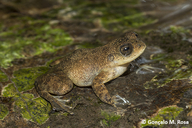|
Description
M 25-32 mm, F 24-34 mm. Similar to M. madecassus but with unpaired subarticular tubercles and with a more uniform dorsal colouration (Glaw and Vences 2007). Distribution and Habitat
Country distribution from AmphibiaWeb's database: Madagascar
Ankaratra (Nosiarivo, Ambohimirandrana) (Glaw and Vences 2007). Occurs in a single, small area at 2,200m asl on the Ankaratra Massif in central Madagascar (Vences and Nussbaum 2008). This site is within 443 m of the highest Ankaratra summit (2,643 m asl) (Vences and Nussbaum 2008). The habitat was formerly montane rainforest but is now high-altitude grassland with remnants of forest (Vences and Nussbaum 2008). This species is found in or near fast montane streams on the Massif (Vences and Nussbaum 2008).
Life History, Abundance, Activity, and Special Behaviors
Habits: Prefers fast-flowing high-altitude streams in the Ankaratra Massif. Specimens have been observed during the day basking on large rocks under a cascade, diving immediately when approached. Probably a rather aquatic species that spends long periods under water (Glaw and Vences 2007).
Calls: Unknown (Glaw and Vences 2007).
Trends and Threats
Rare, and decreasing. In the last 20 years, it has only been recorded from a single stream on the Ankaratra Massif despite several surveys (Vences and Nussbaum 2008). The main threats to its habitat on the Ankaratra Massif are fire, grazing, and potato farming. Water pollution and stream sedimentation as due to agriculture and mining may also be threatening this species. As a mountaintop species, it could also be at risk from the effects of global warming. It is not known from any protected areas, and the protection of remaining habitat on the Ankaratra Massif is urgently needed. Further survey work is needed to determine whether or not the species might exist elsewhere on the Ankaratra Massif, and to determine the current population status (Vences and Nussbaum 2008). Possible reasons for amphibian decline General habitat alteration and loss
Intensified agriculture or grazing
Mining
Local pesticides, fertilizers, and pollutants
Climate change, increased UVB or increased sensitivity to it, etc.
Comments
Taken with permission from Glaw and Vences (2007) and Vences and Nussbaum (2008).
References
Glaw, F., and Vences, M. (2007). Field Guide to the Amphibians and Reptiles of Madagascar. Third Edition. Vences and Glaw Verlag, Köln.
Vences, M. and Nussbaum, R. (2008). Mantidactylus pauliani. In: IUCN 2008. 2008 IUCN Red List of Threatened Species. www.iucnredlist.org. Downloaded on 31 March 2009.
Originally submitted by: Miguel Vences and Frank Glaw (first posted 2009-03-31)
Edited by: Kellie Whittaker (2009-04-09)Species Account Citation: AmphibiaWeb 2009 Mantidactylus pauliani <https://amphibiaweb.org/species/6556> University of California, Berkeley, CA, USA. Accessed May 24, 2025.
Feedback or comments about this page.
Citation: AmphibiaWeb. 2025. <https://amphibiaweb.org> University of California, Berkeley, CA, USA. Accessed 24 May 2025.
AmphibiaWeb's policy on data use.
|





 Map of Life
Map of Life